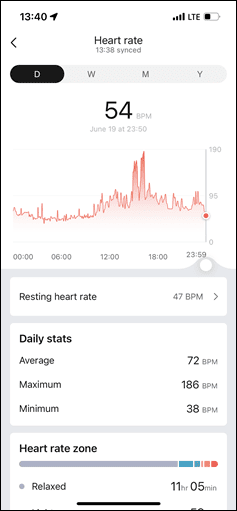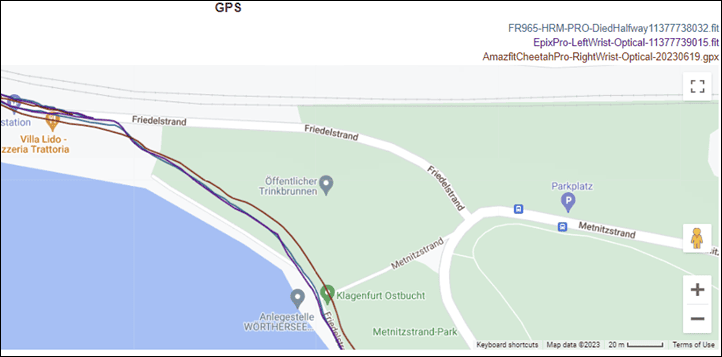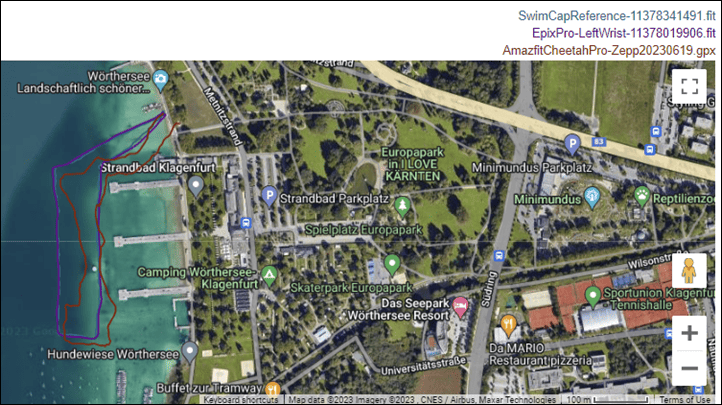Amazfit has just announced their new Cheetah Pro GPS watch, which is aimed to compete in the lightweight but still packed with features category of endurance sports watches. Coming in at just 43g and just $299, it slots in well competitively against many players. But as is always the question with Amazfit, are these features well integrated, or just checkmarks on a spec sheet?
For example, the unit has Amazon Alexa support, as well as the ability to take calls from the wrist (using it as a microphone). Further, it’s got new dual-frequency/multiband GNSS/GPS support, as well as packing a 1.45” brilliantly colorful AMOLED display with mapping & navigational support. That’s in addition to existing features like structured workout training, training load/recovery metrics, and more.
As noted by the title, I’ve been giving this watch a whirl nonstop for the last week, seeing how it handles with my day-to-day workouts, and how it compares to other options on the market – both from a daily usage standpoint as well as an accuracy perspective. In Amazfit’s press materials, they put a lot of emphasis on the accuracy of the GPS, so in particular I wanted to see how well that piece did.
This review will be a bit shorter than usual, mostly because I’m honestly not terribly sure there’s a ton of interest in this watch. So I’m going to focus on the key things that have left an impression, rather than lots and lots of text explaining how more basic things work. I’ve also been testing the Amazfit T-Rex Ultra the last few months, and thus have quite a bit of experience now with the Amazfit/Zepp platform. This is in many ways a mini version of the Amazfit T-Rex Ultra, though, Amazfit also released the Cheetah (non-Pro), which is $229. That watch lacks WiFi/maps/speaker/mic bits.
The Key Specs:
So, just to level-set things a bit, here are the key specs on the Amazfit Cheetah Pro:
– 1.45” color touchscreen AMOLED display
– 34g weight without strap, or 43g with included strap
– Included voice speaker & microphone for calls (with phone nearby)
– Added Amazon Alexa voice assistant support
– Music playback via MP3 (2.3GB, also supports Bluetooth headphones)
– Multiband/Dual-Frequency GNSS support
– 150 sport profiles/modes
– Offline map support (with WiFi downloads)
– Basic navigation support (route import from GPX file)
– Optical HR sensor on the back, including SpO2 readings
– Battery life 14 days smartwatch, 26 hours best GPS mode, 44 hours automatic mode, and 54hrs power saving
– Water resistant to 5ATM (50m)
– Price $299USD
So essentially, it’s designed to compete (per Amazfit’s own press/marketing comparison materials) with everything from the COROS Pace 2 ($199) and Huawei GT Runner ($199) at the low end, to the Garmin Forerunner 965 ($599) at the high end – and then, of course, the Garmin Forerunner 255/265 in the middle of that range. And the thing is, it does, just not everything, everywhere, all at once.
Meaning, like most comparisons, there are features that Amazfit does well and they compete on well. And then in other areas, it falls short. For example, from a navigation standpoint, the mapping feature is done better here than on the COROS Pace 2, simply because there is no mapping on the COROS Pace 2. But inversely, the recently added navigation to the COROS Pace 2 is better than here, because loading routes onto the Amazfit Cheetah Pro is a cumbersome and messy process (as they don’t support routing platforms like Strava Routes or Komoot Routes). So you have to shuffle a bunch of GPX files around like it’s the year 2004 again.
Likewise, while Garmin’s Forerunner 265 or Forerunner 965 doesn’t have voice speaker/mic support (nor Amazon Alexa support), it has approximately 9,238 other fitness/sport features. And virtually all of those are implemented better than what Amazfit has (based on testing here and with the Amazfit T-Rex Ultra). But then again, you get what you pay for. Or, you get what feature you want.
Point is, that this is really a case of ‘which feature do you want’ for each thing. Let’s dive into that a bit more.
General Usage:
We’ve gotta start with the default watch face, because it’s so much Cheetah Cheetos goodness that it can’t be ignored. This is clearly gonna be a love it or hate it kinda situation, and of course, you can change it. When I first powered it on, my thought was “Good god how do we get rid this!”, however, the flagrantly burning situation it is has kinda grown on me. I might even like it, in a rubber-necking car crash kind of way.
Around the outer edge is that red burning sensation, that’s actually the current seconds, it slowly rotates around the bezel like a slow-moving forest fire. In the middle-upper portion of your screen is the most recent activity, except when it’s not. It seems to be the most recent run – as it ignored my swims. Next to that is 24HR illuminated, whereas lower down you’ll see 12HR not illuminated. This is to help you remember how many hours are in the day, and which mode it’s currently in. I have no idea why this would need to be on the watch face, but then again, we’ve long since passed that point here.
To the right are a slate of metrics, most of them self-explanatory. The coloring of the red/orange portion of the screen appears to be the same no matter what happens with any of the metrics within it – ensuring that’s always Cheetah Cheetolishous.
Now the unit has a fabric strap, which keeps it lightweight, or at least feeling lightweight – the strap itself only weighs 9g. The quality of the strap feels good, and the strap itself feels nice. Like all fabric straps, it retains water, so post-shower you need to be careful of where you place your wrist, or else you get a damp spot on your shorts/pants/crotch/wherever.
But yes, the watch is super-duper thin, love it:
On the back you’ll find the optical heart rate sensor package:
This sensor is used for 24×7 heart rate, as well as workout heart rate. All of these 24×7 metrics show up on the widget tiles if you swipe down, which are easily customizable right from the watch:
You can tap on any of these widgets/tiles to get more information, such as steps or sleep:
I’ve found sleep tracking good in terms of the fall-asleep/wake-up time, however, they don’t remember to subtract any ‘awake’ time from your total, or, they don’t actually seem to calculate it at all. In fact, only one night in the last week had just a single minute of ‘awake’ time. I promise you, I’ve been ‘awake’ more than one minute during the last week’s worth of sleeping.
All of this information is viewable within the Amazfit app, which is confusingly called ‘Zepp’. Zepp is actually the company that ‘owns’ Amazfit the brand. And while that’s fine to have parent company names, Amazfit doesn’t use the alternate names field within their app, so if you search for ‘Amazfit’, it doesn’t actually find it in your list of apps. If you have to remember to search for Zepp each time (and not Zeep, or Zip, or Zippo, or Zanny). Again, these are minor things, but that’s sort of the general theme of Amazfit stuff – it’s lots of little minor quirks. Given only Amazfit products (treadmill, weight scale, watches, bands, earbuds – all branded Amazfit) seem pairable within this app, I’m not clear why it would be named Zepp.
But again, the data here is all very easily understandable and clean – and I don’t really have any complaints in terms of the app and normal 24×7 type metrics (or even viewing workouts after the fact).
Next, we get to the Amazon Alexa integration. For this you’ll authorize the watch via Amazon, which takes a few seconds, and then you’re off and running. To access Alexa, you’ll long-hold the upper right button, which then contacts Jeff Bezos and Company.
Except, it doesn’t always work. And certainly never fast. Most of the time it errors out. But every once in a while I get to hear the voice of Alexa herself, answering my hopes and dreams, which I communicate to her via the built-in microphone, and hear back via the built-in speaker. All of which are seemingly fine.
In fact, during workouts you’ll get splits announced via the built-in speaker, which is nice. Speaking of which, let’s talk about workouts.
Sports Bits & Accuracy:
Now let’s take a look at the sport modes a bit. Amazfit has a giant list of sport modes, though I mostly focused on swim/bike/run – since that’s my jam. To access the sport modes, you’ll hit the upper right button/bezel, and then choose ‘Workout’, from there you can choose which sport mode you want. After which you’ll get GPS waiting screen:
If you want to load a route up, you can. In my case, I ran with a route last night around Frankfurt, and getting it onto the watch is kinda messy because you need to transfer the .GPX file to your phone, then use a Files app or such to open it with the Zepp app, then save/name it, then tell it to send to the watch, and then also finally force a manual sync.
There’s also the matter of getting the maps onto the watch. I’ve found this super hit or miss. To load maps, you’ll select an area within the companion app, and then choose to send it to the watch. You’ll need a WiFi access point to download the maps (like most watches), and it’ll go off and download them…in theory. I never tried a big 200KMx300km section, only trying much much smaller little tidbits.
While in Austria last weekend I loaded the maps for that region without too much trouble. But then when I tried to add both my home Amsterdam maps as well as the maps for Frankfurt, it’d pretend to work for a while, and then randomly fail halfway through. I tried this repeatedly on and off over a few hours, and it kept failing – whereby I eventually gave up. This pattern roughly matches what I’ve seen on the Amazfit T-Rex Ultra Pro. Sometimes map downloads work, and sometimes they fail. And there’s no discernable pattern that I can figure out over the last 3 months.
In any case, once up and running you’ll see your data pages as configured. To scroll through them you can use touch or the digital crown. Long-time readers will know that I generally find digital crowns to be miserable in sport usage (such as to navigate features while running), and that’s the case here as well. It sucks for sports when Apple did it, it sucks with COROS did, and it sucks here too. Sorry, I’m steadfast in my suckage assignment. However, what’s key is when and where each company leverages it – such as to try and minimize the suck.
For example, on the Cheetah Pro by default, it’ll lock the display most times you put your wrist down during a workout – requiring you to try and fiddle with the digital crown each time to change to a different data page. Yet sometimes, it won’t still be locked. Then sometimes it will – again, requiring you to spin the digital crown a bunch to unlock. I can find auto-lock settings related to general usage, but not sport usage.
As for visibility of the data pages, the ones with numbers on them are easy to see – no problems in bright sunlight seeing those, as seen below:
Yet navigation pages remain hard to see. This is also true of the Amazfit T-Rex Ultra – even with map data on there. The colors/contrast just aren’t super clear. Here’s a map-less shot from my run last night (because I couldn’t get the maps to download), and while the route line is visible, it’s not as crispy as the other pages.
Switching topics entirely, you’ve got training load. You’ll see this post-workout, as well as within the app. And to Amazfit’s credit here, the training load numbers (per workout) almost exactly match what I get from my Garmin watches. Like, within a few units (e.g. 211 vs 208). This is somewhat notable, because even with my T-Rex Ultra testing, when the optical HR sensor would produce wonky results, it’d still manage to give me near identical training load and recovery values.
So what about GPS, elevation, and HR accuracy? Well, that depends on the sport. In Amazfit’s press bits they touted superior GPS accuracy in city environments, as well as more mundane ones – even showing a screenshot where unnamed competitors had failed. But in my testing, that didn’t really hold up. If I look at easier runs first, such as this one last week, it wasn’t nearly as precise (when in ‘Precision mode’) as Garmin’s SatIQ setting (which is an automatic GPS mode). It wasn’t bad, but it just wasn’t crispy sharp. Here’s an example of that in a relatively open area, with the Cheetah Pro meandering a bit:
Likewise, with my run last night in Frankfurt, it struggled in one block next to some rather tall buildings. Ironically, so did both Garmin units, the first time I’ve really seen Garmin’s multiband config truly struggle – even when they’ve nailed the much harder NYC test I’ve done. In the below section of street, I had stayed on the left side – so you’re looking at classic skyscraper GPS signal reflection.
For the rest of the run along the river, the units were basically a wash:
Heart rate accuracy actually seems pretty much OK, an improvement from the Amazfit T-Rex Ultra, which has been not-so-hot. Here’s last night’s Frankfurt:
And then here’s an interval set from the previous run. Ignore that line that drops out half-way, that’s when I forgot to replace the battery on the chest strap, and it died halfway (and defaulted to the optical HR sensor for that watch, which wasn’t on my skin). But as you can see, pretty happy with the Amazfit results here for what was hard 400m intervals:
And then when it came to openwater swimming, it wasn’t even close. The Amazfit struggled very heavily here, adding hundreds of meters of distance, and the look of a drunk swimmer (the red line):
Adding to that, the day before, while recording a simple 2-hour ride on flat ground chasing my wife around her Ironman race, it produced a stunning 23,651ft (7,209m) elevation gain, for no obvious reason.
The next day it continued to warn me I was at ‘high altitude’ and to be mindful while training – but just look at this elevation graph!
You can calibrate the altimeter, but it doesn’t appear to properly calibrate itself using GPS (as a baseline). For my next few runs, it still thinks I’m at 10,000ft somehow.
Wrap-Up:
The Amazfit Cheeta Pro, on paper, represents an incredible value for a GPS smartwatch focused on athletics. After all, it’s got a brilliant display, reasonably good battery life, plenty of sport modes, and mostly good heart rate accuracy. Plus, it even does training load and recovery and has maps. And yes, when all those pieces work, it works well.
The trick though with Amazfit watches is that there’s almost always a ‘but’. As in, the maps are there, but, they don’t always download. Or the altimeter works well, but sometimes it doesn’t. Or the Amazon Alexa is cool, but sometimes it doesn’t respond. The display is beautiful, but only if you can get it unlocked. And on and on. Yes, there’s incredible value to be had, but only when it works as you’d expect.
In many ways, Amazfit reminds me of where COROS was a few years ago. They were in the ‘just keep releasing new watches’ mode, without every investing in the software quality or app features. I commented at the time that COROS’s problem wasn’t having new models, it was having software that was polished and without all sorts of weird caveats. Since then, they’ve made lots of really good progress on software, while reducing (significantly) the number of units they’re releasing. Amazfit hasn’t reached that point yet – it’s still in ‘Just keep releasing new watches’ mode.
As such, while they make that first sale, many comments I get from DCR readers suggest that they can’t keep that customer longer term, because the customer base gets frustrating with a lack of fixes for issues. One only need to view Reddit threads to re-confirm that widely held opinion.
Again – on paper, and even person, the Amazfit Cheetah Pro is a beautifully stunning lightweight sport watch. It really is. But all too many times in the last week I kept finding these cracks in the façade, which make it harder to justify. Sure, it looks prettier than the COROS Pace 2, but functionally speaking, the less expensive COROS Pace 2 is just more dependable and works better.
If Amazfit can focus on feature quality and nailing all the nuanced things that athletes come to expect from even a $300 GPS sport watch, they could pose a significant challenge to the existing endurance sports players in the industry.
With that – thanks for reading!
![clip_image001[40] clip_image001[40]](https://media.dcrainmaker.com/images/2023/06/clip_image00140_thumb.jpg)
![clip_image001[38] clip_image001[38]](https://media.dcrainmaker.com/images/2023/06/clip_image00138_thumb.jpg)
![clip_image001[6] clip_image001[6]](https://media.dcrainmaker.com/images/2023/06/clip_image0016_thumb-4.jpg)
![clip_image001[10] clip_image001[10]](https://media.dcrainmaker.com/images/2023/06/clip_image00110_thumb-3.jpg)
![clip_image001[19] clip_image001[19]](https://media.dcrainmaker.com/images/2023/06/clip_image00119_thumb.jpg)
![clip_image001[8] clip_image001[8]](https://media.dcrainmaker.com/images/2023/06/clip_image0018_thumb-4.jpg)
![clip_image001[13] clip_image001[13]](https://media.dcrainmaker.com/images/2023/06/clip_image00113_thumb.jpg)
![clip_image001[15] clip_image001[15]](https://media.dcrainmaker.com/images/2023/06/clip_image00115_thumb.jpg)
![clip_image001[17] clip_image001[17]](https://media.dcrainmaker.com/images/2023/06/clip_image00117_thumb.jpg)
![clip_image001[6] clip_image001[6]](https://media.dcrainmaker.com/images/2023/06/clip_image0016_thumb-2.png)

![clip_image001[10] clip_image001[10]](https://media.dcrainmaker.com/images/2023/06/clip_image00110_thumb.png)
![clip_image001[12] clip_image001[12]](https://media.dcrainmaker.com/images/2023/06/clip_image00112_thumb-1.png)
![clip_image001[14] clip_image001[14]](https://media.dcrainmaker.com/images/2023/06/clip_image00114_thumb.png)
![clip_image001[21] clip_image001[21]](https://media.dcrainmaker.com/images/2023/06/clip_image00121_thumb.jpg)
![clip_image001[23] clip_image001[23]](https://media.dcrainmaker.com/images/2023/06/clip_image00123_thumb.jpg)
![clip_image001[44] clip_image001[44]](https://media.dcrainmaker.com/images/2023/06/clip_image00144_thumb.jpg)
![clip_image001[16] clip_image001[16]](https://media.dcrainmaker.com/images/2023/06/clip_image00116_thumb.png)
![clip_image001[18] clip_image001[18]](https://media.dcrainmaker.com/images/2023/06/clip_image00118_thumb.png)
![clip_image001[20] clip_image001[20]](https://media.dcrainmaker.com/images/2023/06/clip_image00120_thumb.png)
![clip_image001[42] clip_image001[42]](https://media.dcrainmaker.com/images/2023/06/clip_image00142_thumb.jpg)
![clip_image001[27] clip_image001[27]](https://media.dcrainmaker.com/images/2023/06/clip_image00127_thumb.jpg)
![clip_image001[33] clip_image001[33]](https://media.dcrainmaker.com/images/2023/06/clip_image00133_thumb.jpg)
![clip_image001[35] clip_image001[35]](https://media.dcrainmaker.com/images/2023/06/clip_image00135_thumb.jpg)
![clip_image001[29] clip_image001[29]](https://media.dcrainmaker.com/images/2023/06/clip_image00129_thumb.jpg)
![clip_image001[31] clip_image001[31]](https://media.dcrainmaker.com/images/2023/06/clip_image00131_thumb.jpg)






![clip_image001[25] clip_image001[25]](https://media.dcrainmaker.com/images/2023/06/clip_image00125_thumb.jpg)
![clip_image001[22] clip_image001[22]](https://media.dcrainmaker.com/images/2023/06/clip_image00122_thumb.png)
![clip_image001[24] clip_image001[24]](https://media.dcrainmaker.com/images/2023/06/clip_image00124_thumb.png)
![clip_image001[46] clip_image001[46]](https://media.dcrainmaker.com/images/2023/06/clip_image00146_thumb.jpg)


0 Commentaires